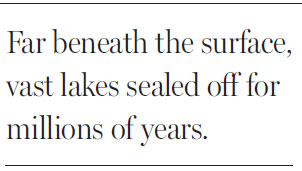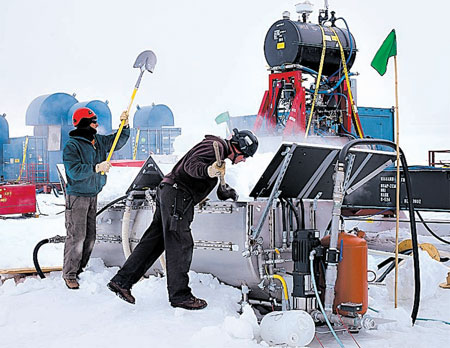Drilling in ice for otherworldly life
Updated: 2013-01-27 08:26
By James Gorman(The New York Times)
|
|||||||||
|
A project to bore through 800 meters of ice to find rare life forms may offer clues to life elsewhere in the universe. J.T. Thomas |

Three major scientific projects set out this season to seek evidence of life in lakes deep under the Antarctic ice - evidence that could provide clues in the search for evidence of life elsewhere in the solar system, perhaps in Mars's past, or even now under the surface of Enceladus, one of Saturn's moons. But only one of the projects, a $10 million expedition from the United States, has a chance of identifying long-hidden microbes before the weather on the frigid continent puts an end to drilling in a few weeks.
One of the projects, a British effort, ran into technical trouble and had to be called off. An expedition from Russia will be returning samples to be analyzed later.
The American effort is about to start drilling into a lake about 800 meters below a glacier called the Whillans Ice Stream. Both the Russian and British projects aimed to reach waters under three or more kilometers of ice.
While life is known to survive in the deep ocean without photosynthesis, nothing like these cold, freshwater depths has ever been explored. Robin Bell, a senior research scientist at Columbia University's Lamont-Doherty Earth Observatory, who studies the behavior of ice sheets with radar and other techniques, said the subglacial Antarctic lakes hold "whole ecosystems that have never really been looked at."
Chris McKay, an astrobiologist at NASA Ames Research Center, said that exploring extreme environments offered practical lessons for efforts on other planets, "learning how to make measurements in places where there's not much life."
The Lake Whillans researchers also want to understand the flow of water beneath glaciers into the Southern Ocean and the rate of melting of Antarctic ice.
The Russian project, at Lake Vostok, breached its surface last February after a decade of struggling to get through more than three kilometers of ice to water that had been sealed away for millions of years. The Russians are back at Lake Vostok this year to retrieve samples of the water that flowed from the surface of the lake up the drill's bore hole.
The British project also intended to retrieve water samples for later studies, from another, smaller body of water, Lake Ellsworth. But researchers called off that attempt on December 25 because the drilling process ran into difficulty at about 300 meters. The water they had hoped to reach lay about three kilometers deep.
Lake Whillans is smaller and not as deep, and is replenished more quickly from other water sources under the Antarctic ice shelf. It is a basin in a subglacial river where water accumulates to form a lake but keeps flowing, eventually reaching the ocean.
John C. Priscu of Montana State University, a leader of the project, said that while the water in Lake Vostok was replaced about every 10,000 years, and the water in Lake Ellsworth every 700 years or so, the replacement rate for Lake Whillans was more on the order of a decade.
The project involves the use of a remote torpedo-shaped submersible, about a meter long. It will operate on a tether about 1,600 meters long and will be used to map the three-dimensional space of the underground lake, including its inlets and outlets. Understanding the shape of the lake, and how the water moves in and out, is important for knowing how and why the glaciers above these deep lakes move, why parts of Antarctica are gaining and others are losing ice cover.
Glaciologists know of nearly 400 buried lakes in the Antarctic. They can serve as a lubricant between the mountains and valleys of the land mass, and the vast amounts of ice under which it is buried.
The team will also be taking samples from the sediments at the bottom of the lake, to look for living microbes or chemical evidence of past activity.
By January 21, when Dr. Priscu hoped drilling would begin, there would be about 50 people at the camp.
He said there are no guarantees as to what the team might find, but he is hopeful, given that "10 years of circumstantial evidence" suggest that "there should be a viable microbial community that's living in the dark and the cold."
The New York Times
(China Daily 01/27/2013 page11)
